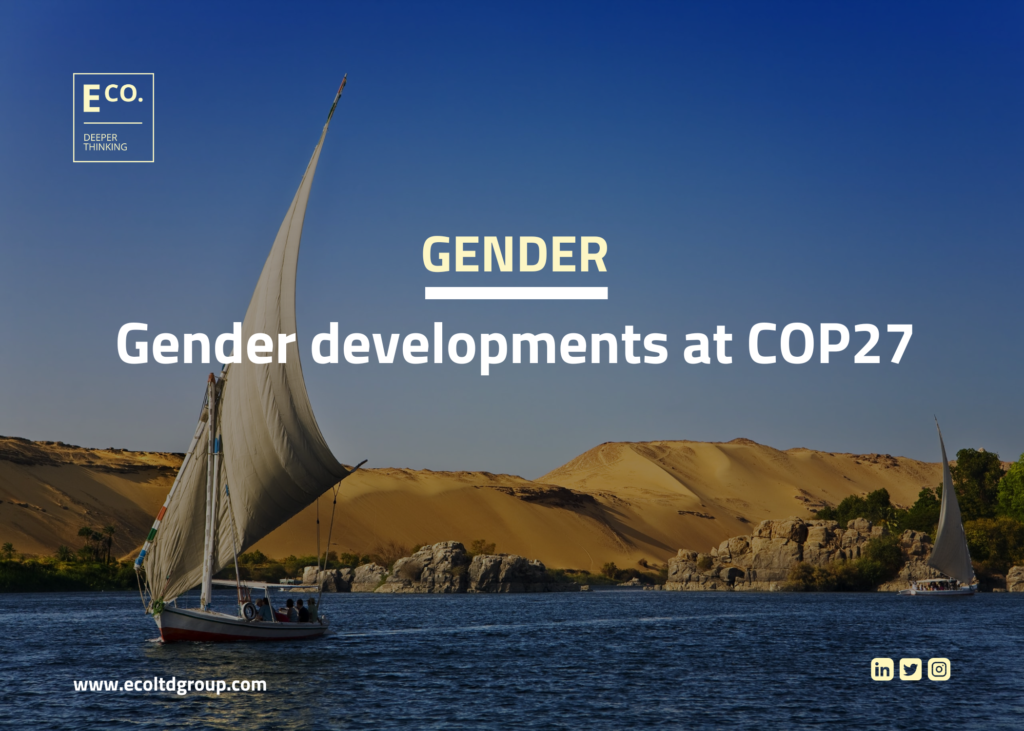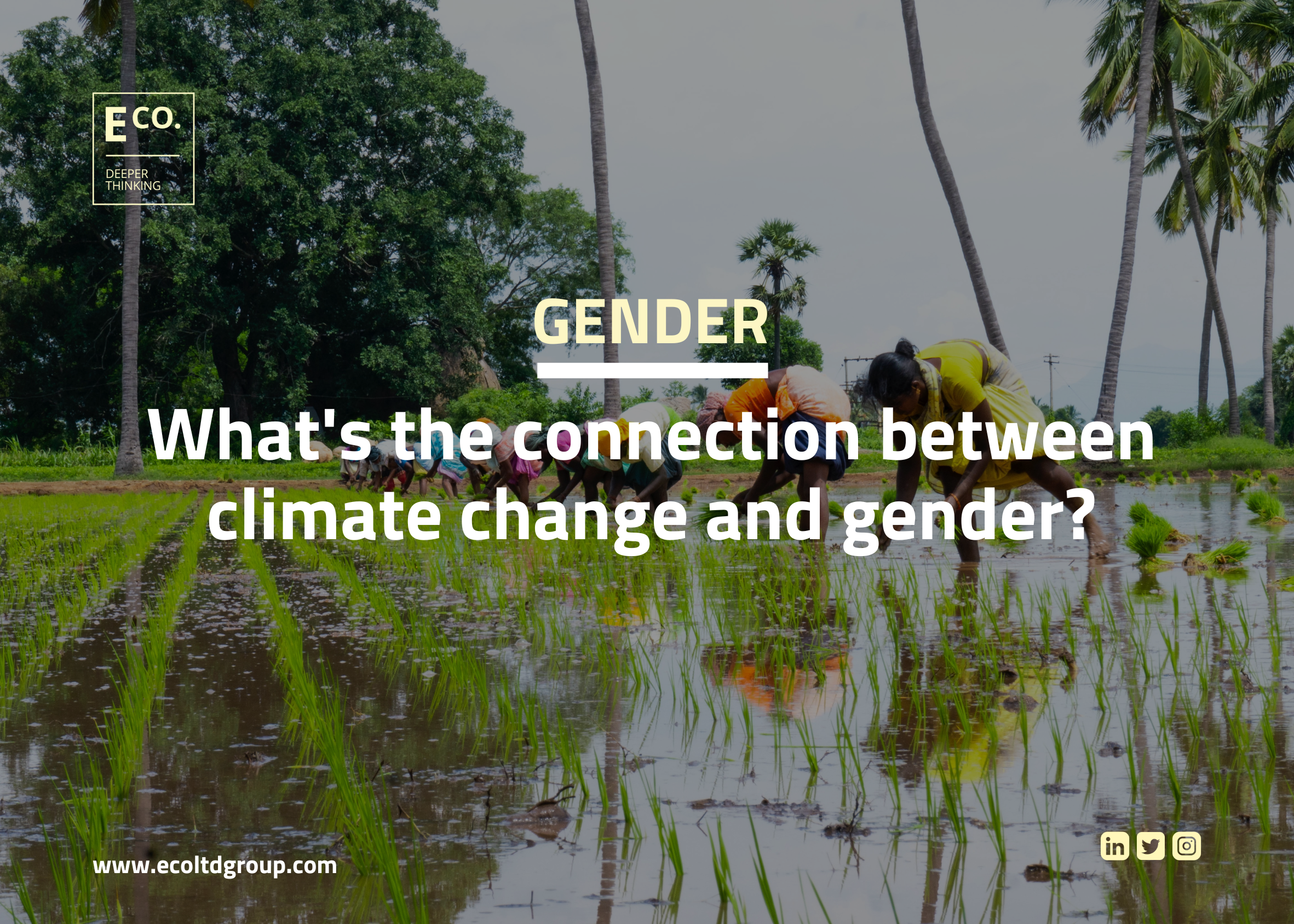Gender developments at COP27
7 February 2023, Category: All insights, News, Tags: climate change, climate finance, COP27, egypt, gender, gender equality, gender mainstreaming

Underscoring the conversations surrounding adaptation and loss and damage at COP27 was a vital and ongoing debate on gender. This article is a round-up of key gender decisions made at 2022’s climate summit.
With COP27’s proceedings divided into eight thematic days, the 14 November was allocated as Gender Day, with the view to ‘provide a platform to discuss existing challenges and to share success stories from around the world with a view to increasing awareness and sharing experiences and promoting gender sensitive and responsive policies, strategies and actions.’
However, discussions on gender weren’t restricted to this day. Rather, gender-focused proceedings that discussed the important matters of gender and its relation to wider climate agendas were observed over the course of the entire event. As women and girls often bear the burden generated by uneven impacts of climate change, ensuring that their, agency, needs, and opinions are fully incorporated into policy making is the best way of ensuring inclusion and equitable outcomes—especially within the most climate-vulnerable communities.
Here is a round-up of the COP27 gender decisions.
- COP27’s key gender decision
- The participation of women at COP27
- Gender spotlight
- The must-read gender reports
COP27’s key gender decision
At COP 27, Parties concluded the intermediate review of the implementation of the gender action plan that started at the Bonn Climate Change Conference (SB 56) in June 2022. The review included amendments to some deliverables and three new activities in priority areas C (‘Coherence’) and E (‘Monitoring and Reporting’).
The UNFCCC’s gender action plan (GAP) contains five of these priority areas, which set objectives for enhancing gender-responsive climate action and the mainstreaming of gender and related concepts within the work of Parties, the secretariat, and all UN entities, amongst others.
The developments taken within the intermediate review essentially aim at refining the GAP, the Enhanced Lima Work Programme on Gender (LWGP), and providing more concrete timelines and reporting mechanisms, as well as broadcasting the “support available to developing country Parties for reporting on the implementation of the gender action plan”.
The adopted decision is available here.
Sign up for our free gender training session
With mounting evidence on the disproportionate impacts of climate change on women and girls, how can we ensure that climate finance takes their needs into account? Join our upcoming training session on Tuesday, 28 February and learn all about what gender considerations can be included in climate finance projects, the key to gender action plans, and myths surrounding the concept.
Join by clicking this link.
The participation of women at COP27
Ensuring that decisions made on gender at the national and international level is vital for reaching the necessary goals and objectives that ultimately make gender-responsive policies work. However, creating a space for women at COPs—and within the wider world of environmental/political thought—is still a process far behind where it needs to be.
Historically, participation by women has been low:
- In 2009, women made up 10% of the Heads of Delegations.
- In 2021, this had risen to 13%.
However, this rise hasn’t been a linear one. 2015 experienced a low of 9%, while 2017 saw a high of 26%. As 2009’s COP15 and 2015’s COP21 are largely considered pivotal moments within COP history. In an article released by the Women’s Environment & Development Organisation (WEDO), it stated that “as more senior officials take up the role as Head of Delegation, the more likely they are to be men.”
WEDO went on to state that if the pace of change is not increased, gender parity will only be achieved in 2040—and that’s only for national COP delegations. If we are to apply the same analysis to COP Heads of Delegations, gender parity “will not be achieved within the forecastable future”.
You can explore the data relating to women’s participation in the UNFCCC here.
Gender spotlight: ‘Gender Data Must Be the Bedrock of Climate Justice’
In a joint policy brief released by WEDO and the International Institute for Sustainable Development (IISD), it calls for gender data to be prioritised within UNFCCC processes and mechanisms:
The collection and use of gender data can help address entrenched climate inequalities and inform solutions that reflect their lived experiences. In other words, gender data can save lives and livelihoods by revealing economic, political, and social barriers and informing targeted solutions that improve climate resilience.
The policy brief advocates for several strategies going forward that advance gender within climate dialogues:
- Promote collaboration across sectors, including with national statistical offices (NSOs).
- Support climate resilience goals by investing in gender data systems.
- Ensure women’s engagement and equitable participation in both decision-making and data collection processes.
These are important policy recommendations, particularly because addressing gender inequality ensures we have equitable outcomes in our climate resilience agenda. However, this can be achieved only if we’re able to collect and use data that pertains to the circumstances and experiences of people of all gender identities and other forms of social exclusion. Paucity of vetted, gender data is necessary for climate investments – whether intended for adaptation, mitigation and cross-cutting projects and programmes.
The must-read gender reports
Alongside COP27 gender progress, there are also several must-read reports that have recently been released regarding gender and the experiences of women in relation to climate change:
Women confronting loss and damage in Africa
This new report from ActionAid UK uncovers the impacts of climate-induced loss and damage effects on women who are at risk of marginalisation. It analyses groups who live in Kenya, Nigeria, Rwanda, and Zambia.
Climate Action with Gender Equality: Towards Transformative Recovery for Sustainability and Gender Equality in Latin America and the Carribean
[Spanish only]
Published by CEPAL, this report highlights the best practices, opportunities and challenges for mainstreaming gender equality within climate action in the Caribbean and Latin American countries.
Gender Integration in NDCs: A Commonwealth Best Practice Guide
This guide is published by the Commonwealth, and covers the best practices for Commonwealth member countries to integrate gender into Nationally Determined Contributions (NDCs).
Gender equality, labour and a just transition for all
Part of the ILO Just Transition policy briefs, this document details the relationship between the concept of just transition and gender equality and labour, and goes on to provide recommendations for implementation routines.
The links between gender equality and climate change
Ultimately, COP27 represents a small albeit significant part in the conversation surrounding gender. The entire conversation is both crucial and complex, and includes a vast amount of readings and interpretative stances.
If you’re curious about this conversation and the general shape of it within the international context today, read our article here, which explores the main questions on gender and climate change.
Work with our consultants on your climate-resilient projects today
Let’s accelerate progress together: Get in touch with our climate finance consultants to discuss a project you’re working on. Email us at: amy@ecoltdgroup.com or find us at the following:
Twitter: @ecoltdnews
LinkedIn: E Co.
Instagram: @ecoltdnews
Please feel free to share your comments below or send an email to: gcfinsight@ecoltdgroup.com
One Reply
Join the conversation by posting a comment below. You can either use your social account, by clicking on the corresponding icons or simply fill in the form below. All comments are moderated.


[…] Read this article here. […]